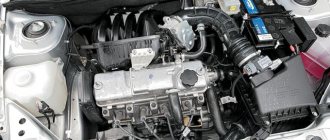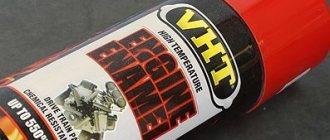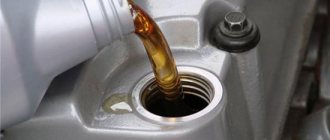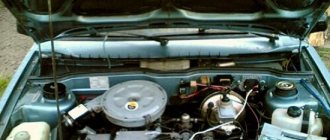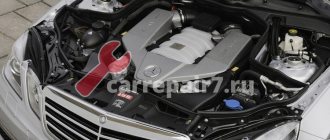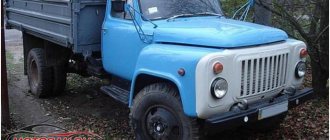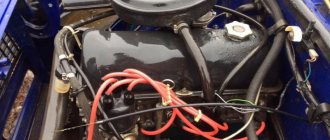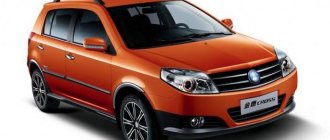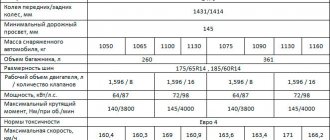Experts consider the VAZ 11186 engine as a modernization of the 21114 engine, a secondary modification of the 21083, or an improvement in the characteristics of the 11183 internal combustion engine. The first option is considered more correct, since the design of 11186 and 21114 is absolutely identical, with the exception of the pistons. The 11186 engine is equipped with AvtoVAZ products, and the previous version of the internal combustion engine was equipped with pistons from the manufacturer Federal Mogul (USA), which developed it under a contract with the Volzhsky Automobile Plant.
ICE 11186 compared to 11183
Characteristics of motor 11186
The project of a “people's car” at a budget price for the average LowCost user was seriously hampered by the economic crisis. For the Lada Granta Standard configuration, the technical characteristics of the existing ICE 11183 were sufficient.
However, for the Norma and Lux trim levels, a more powerful internal combustion engine was needed, so the management of AvtoVAZ, not having sufficient funding for the project of a new engine, came out of the situation as follows:
- the existing version 21114 became the basis for the ICE 11186;
- to reduce costs, pistons from the American manufacturer Federal Mogul were replaced with domestic products of a suitable size;
- The manufacturer changed the engine markings, but no more design changes were made.
Piston 11186 is smaller than 11183
Unlike 11183, the piston of the 11186 motor bends the valve when the timing belt breaks, but the performance characteristics are improved:
| Manufacturer | AvtoVAZ |
| Engine brand | 11186 |
| Years of production | 2011 – … |
| Volume | 1598 cm3 (1.6 l) |
| Power | 64.2 kW (87 hp) |
| Torque moment | 140 Nm (at 3800 rpm) |
| Weight | 140 kg |
| Compression ratio | 10,5 |
| Nutrition | injector |
| Motor type | in-line |
| Injection | electronic multipoint |
| Ignition | the electronic unit |
| Number of cylinders | 4 |
| Location of the first cylinder | TVE |
| Number of valves on each cylinder | 4 |
| Cylinder head material | aluminum alloy |
| Intake manifold | plastic receiver, electronic throttle |
| An exhaust manifold | combined with catalyst |
| Camshaft | from 11183 |
| Cylinder block material | cast iron |
| Cylinder diameter | 82 |
| Pistons | lightweight |
| Crankshaft | ductile iron, oil channels |
| Number of main bearings | 5 |
| Piston stroke | 75.6 mm |
| Fuel | AI-95 |
| Environmental standards | Euro 4 |
| Fuel consumption | highway – 5.7 l/100 km combined cycle 7.3 l/100 km city – 8.5 l/100 km |
| Oil consumption | maximum 1 l/1000 km |
| Engine oil for 11186 | 5W-30 and 10W-30 |
| Engine oil volume | 3.5 l |
| Operating temperature | 95° |
| Motor life | declared 150,000 km actual 300,000 km |
| Adjustment of valves | washers between camshaft cams and tappets |
| Cooling system | forced, antifreeze/antifreeze |
| Coolant quantity | 7.8 l |
| water pump | polymer impeller |
| Candles for 11186 | BPR6ES, A17DVRM |
| Gap between spark plug electrodes | 1.1 mm |
| Timing belt | 163 teeth, pitch 8 mm, belt width 26.7 mm |
| Cylinder operating order | 1-3-4-2 |
| Air filter | Nitto, Knecht, Fram, WIX, Hengst |
| Oil filter | catalog number 90915-10001 replacement 90915-10003, with check valve |
| Flywheel | from 2110, steel crown placed on a cast iron body |
| Flywheel mounting bolts | box MT – M10x1.25 mm, length 26 mm, groove 11 mm box AT – M10x1.25 mm, length 26 mm without groove |
| Valve stem seals | code 90913-02090 inlet light code 90913-02088 exhaust dark |
| Compression | 13 bar |
| XX speed | 650 – 750 min-1 |
| Tightening force of threaded connections | spark plug – 18 Nm flywheel – 62 – 87 Nm clutch bolt – 19 Nm bearing cap – 68 Nm (main) and 53 (rod) cylinder head – three stages 29 Nm, 49 Nm and 90° |
Since the engine does not have hydraulic valve lash compensators, it is practically not important for the user which oil to choose based on the fuel manufacturer. Both domestic and foreign companies are suitable, for example, ZIK, Lukoil, Mobil, Rosneft. On the other hand, relevant information is which oil to pour into the engine based on viscosity:
- for regions of the Russian Federation, the manufacturer recommends all-season oils 10W40, 5W40 and 15W30;
- Synthetic and semi-synthetic lubricants are allowed;
- It is better not to use mineral oil.
To reduce temperature loads on the valves, the engine circuit provides nozzles that inject oil onto their surface. Unlike homemade channels, nozzles fire only when pressure increases, that is, when the lubricant heats up from intense loads. Oil does not enter the crankcase and does not cause increased wear of gaskets in the engine.
Lada Granta engines 16 valves
This engine is also equipped with a lightweight piston group manufactured by Federal Mogul and a belt with an automatic tensioner from Gates. It is distinguished by a 16-valve head with a pair of camshafts and hydraulic compensators, due to which its power is significantly higher.
All the problems of its predecessors apply to this unit in full. The engine often suffers from lubricant leaks, tripping, floating speed, sensor glitches and valve burnout. Plus, you can add hydraulic compensators that are very demanding on oil quality.
Hatchback before restyling 2015 - 2019
| 1.6 l 21126 MKP5 | 1.6 l 21126 automatic transmission4 | |
| Type | injector | injector |
| Fuel | gasoline AI-92 | gasoline AI-92 |
| Location | transverse | transverse |
| Cylinders | 4 in a row | 4 in a row |
| valves | 16 | 16 |
| Working volume | 1596 cm³ | 1596 cm³ |
| Power | 98 hp | 98 hp |
| Torque | 145 Nm | 145 Nm |
| Acceleration to 100 km/h | 11.2 s | 13.3 s |
| Speed (max) | 182 km/h | 173 km/h |
| Ecological Class | Euro 5 | Euro 5 |
| Consumption city | 8.8 l | 9.9 l |
| Flow track | 5.6 l | 6.1 l |
| Mixed flow | 6.8 l | 7.2 l |
All technical characteristics of the engine are described on the Motor VAZ portal
The updated engine received an adjustable intake tract with dampers in the receiver channels. Also here, the mass air flow sensor gave way to a combination of absolute pressure and air temperature sensors, thanks to which the frequent problem of floating speed at idle has finally gone away.
The reliability of the new unit has increased, although it is not flawless. The thermostat also often fails, the injectors become clogged, and the ignition system malfunctions. But the main threat is the water pump, because of the wedge of which the timing belt breaks and the pistons meet the valves. Update: In July 2022, the manufacturer equipped this engine with plugless pistons.
Hatchback before restyling 2015 - 2019
| 1.6 l 21127 MKP5 | 1.6 l 21127 AMT5 | |
| Type | injector | injector |
| Fuel | gasoline AI-92 | gasoline AI-92 |
| Location | transverse | transverse |
| Cylinders | 4 in a row | 4 in a row |
| valves | 16 | 16 |
| Working volume | 1596 cm³ | 1596 cm³ |
| Power | 106 hp | 106 hp |
| Torque | 148 Nm | 148 Nm |
| Acceleration to 100 km/h | 10.9 s | 12.3 s |
| Speed (max) | 183 km/h | 180 km/h |
| Ecological Class | Euro 5 | Euro 5 |
| Consumption city | 8.6 l | 9.0 l |
| Flow track | 5.6 l | 5.2 l |
| Mixed flow | 6.5 l | 6.5 l |
Design Features
By default, the 11186 engine retains all the design features of the original 21114, from which it originated:
- volume 1.6 l;
- the block height is 2.3 mm greater than that of 2110;
- crankshaft with an increased crank radius by the same 2.3 mm (piston stroke 75.6 mm, respectively);
- ShPG, flywheel and crown from 2110.
Motor design 11186
In addition, a feature for the 11186 engine is the bending of the valves on the pistons when the timing belt drive breaks:
- the piston skirt is reduced here to make it lighter;
- It is physically impossible to make a deep hole for the valve inside the piston.
Diagram of internal combustion engine components 11186
The manufacturer's manual contains a description of the components and parameters of the internal combustion engine, which are most often compared with the characteristics of the 11183 engine, which has the most similar markings. The main differences between these power drives from the same manufacturer are:
- torque is 15 Nm more;
- power 87 l. With. instead of 82 l. With.;
- motor 11186 has been produced since 2011, and its predecessor 11183 since 2004;
- instead of serial pistons from 2110 weighing 350 g, a lightweight version 21116 weighing 240 g is used;
- connecting rod length increased from 121 mm to 133.32 mm;
- the piston skirt has a graphite coating, the metal in the area of the first ring is anodized;
- combustion chamber 30 cm3 instead of 26 cm3;
- compression ratio increased from 9.6 to 10.5;
- The cylinder head gasket is all-metal, its thickness has been reduced from 1.2 mm to 0.43 mm;
- the cylinder head is 1.2 mm higher to compensate for the enlarged combustion chamber;
- the diameter of the bolts was reduced from M12 to M10 to reduce cylinder deformations during tightening;
- the flow channels in the cylinder head have been increased in diameter, nozzles have been installed to cool the piston heads;
- the working chamfer under the valves is maintained longer due to the strengthening of the aluminum alloy using a special technology;
- since the holes in the pistons are not enough to ensure the safety of the valves, a high-strength timing belt from the Gates manufacturer is used;
- the camshaft V-belt received an automatic tensioner, which had not previously been used in VAZ engines;
- the piston system is protected externally from overheating by a cooling jacket integrated into the cylinder block;
- the length of the receiver channels has been increased, the characteristics of the internal combustion engine are close to those of a 16 valve engine;
- the catalytic collector has a flattened block, which made it possible to separate the ducts and get rid of power losses and turbulence;
- the generator is mounted on a bracket, so its drive belt is not overtightened, like 11183, and lasts longer;
- The cabin heat exchanger and expansion tank are included in the thermostat in parallel, the operating error has decreased to 2 degrees instead of 5 degrees.
Crankcase ventilation
Timing belt cover 11186 on the right, improved design
On the right is the catalytic collector 11186 with a rational exhaust circuit
Modified generator mounting unit
New thermostat design
According to the AvtoVAZ plant, the ICE 11186 has a potential of 120 hp. (without resource reduction) or 180 l. With. (the resource will be reduced due to intensive wear of the piston). The manufacturer recommends tuning exclusively through modifications of components and mechanisms without the use of turbines.
Noise level
I switched to this car from the Renault Megane 2. My Renault was equipped with a 1.6-liter engine, a power of 113 horses, and the number of valves was 16.
After it, the Granta engine works like a tractor. Regardless of the car's mileage. Even the engine on the carburetor VAZ-21093 seemed quieter to me.
I specifically compared the noise level on a new Grant with a mileage of 5,000 km and on mine with a mileage of 55,000 km. As it warms up, the sound becomes quieter, but most likely you just get used to it.
Read more about warming up the engine in the article: the need for warming up: myth or fact?
But it is also worth considering that there are no hydraulic compensators, so you will have to adjust the valves. By the way, the engine in the luxury version (98 hp) also rumbles.
Advantages and disadvantages
The main advantage of the motor is the fact that the manufacturer has already managed to increase the power to 64.2 kW. In addition, it is possible to boost the motor without loss of service life. That is, the owner will not have to make major repairs more often than scheduled.
The disadvantages of ICE 11186 are:
- “meeting” of the piston with the valve in the event of a break in the timing belt drive;
- periodic valve adjustment;
- non-repairable ignition unit.
Adjustment of valves
The advantages of the engine in comparison with the existing versions of the internal combustion engine of the AvtoVAZ manufacturer at the time of its creation are:
- do-it-yourself overhaul after the piston group has reached the end of its service life at least 3 times using different repair kits;
- increased volumes of combustion chambers;
- built-in piston cooling system;
- the hinged one is secured with brackets and has automatic tensioners;
- modernization of the cylinder head and crankshaft;
- piston and crankshaft relief;
- use of parts from existing engines.
Therefore, during repairs and tuning there are no problems with spare parts and components. Maintenance is cheaper than foreign-made engines.
Lada Granta with 8-valve engine
Eight-valve engines are considered basic and are presented in two units. Separately, it should be noted that if the timing belt breaks, the valves will not be bent only in one engine - 11183-50, which, by the way, is considered the weakest. Therefore, no matter what happens, the timing belt must be replaced in a timely manner.
This, as mentioned earlier, is the weakest engine of all that is presented in the Grant line. Its power is 82 horsepower. By the way, this engine is considered a more simplified version of what is installed on the VAZ-2111.
But there are also characteristics in which this engine differs from the original. Namely:
- improved environmental performance;
- increased reliability parameters;
- reduced "crankiness".
In addition, the above engine also has such features as high-torque power and elasticity, which is especially important when driving off-road.
The disadvantages of this type of engine are considered to be:
- the need to periodically adjust the valves;
- increased noise when the engine is running.
Benefits include:
- cast iron used as the basis of the cylinder block;
- maximum torque – 125 Nm, which is achieved already at 3 thousand revolutions;
- The compression ratio cannot be higher than 9.6.
- Engine 11186.
This motor is a slightly improved modification of the motor installed on the VAZ-21114.
Regardless of the fact that this engine has an undeniable advantage in the form of 87 horsepower, it also has a significant drawback. The fact is that, compared to the engine we discussed above, this one has a much shorter lifespan, and if the timing belt breaks, the car itself will need to be repaired, since the valves will be bent.
- increased compression ratio (10.5);
- torque - 140 Nm at 3.8 thousand revolutions;
- economical fuel consumption, both during urban driving and on the highway.
- Engine 21116.
This type of engine is completely identical to 11186. The only difference between them lies in the piston system, since it has a French-made piston installed on it.
What cars was it used in?
Created in 2011, the 11186 engine is used as a power drive for several models of the auto manufacturer AvtoVAZ:
- Lada Kalina II – station wagon, sedan;
- Lada Granta (Lux and Norma equipment) – liftback, sedan;
- Lada Priora – sedan, station wagon, hatchback;
- Lada Largus – minivan, station wagon, van;
- Lada Vesta - station wagon;
- Lada XRay is a compact crossover/high hatchback.
Lada XRay
Improved engine characteristics allow it to be used on any front-wheel drive car in the event of a swap rather than engine tuning.
16 valve engines
Sixteen valve engines on the Grant were installed under numbers 126 and 127. Initially, the Grants were equipped with a 126 engine, this engine was installed from 2011 to 2015, later replacing the 126, the 127 engine came, which was installed on the Priora 2 and Lada Vesta.
Engine VAZ 21126
This engine was built on the basis of a 124 engine, which is still famous for its reliability. The 126 engine uses automatic tensioning of the timing belt, which avoids the attraction of the belt, which can lead to its breakage. The 16-valve engine uses hydraulic compensators, which allows the engine to adjust the valve clearance under the influence of oil pressure. Also paired with a 16-valve engine in the LUX configuration, an automatic transmission is installed. A significant disadvantage of the 126 engine is the bending of the valves when the timing belt breaks.
Technical characteristics of engine 21126:
| Fuel supply | Injector |
| Number of cylinders | 4 |
| Number of valves | 16 |
| Compression ratio | 11 |
| Power (hp) | 98 |
| Engine capacity (cc. cm) | 1596 |
| Required fuel | Not lower than AI 95 |
| Torque (N*m) | 145 |
Engine VAZ 21127
The VAZ 127 engine is the flagship of the Volzhsky plant. It is this engine that is currently installed on VAZ cars; thanks to the modified DOHC valve timing, it was possible to significantly increase the power of the power unit, which has a very positive effect on the driving characteristics of the car.
Technical characteristics of VAZ 21127:
| Fuel supply | Injector |
| Number of cylinders | 4 |
| Number of valves | 16 |
| Compression ratio | 11 |
| Power (hp) | 106 |
| Engine capacity (cc. cm) | 1596 |
| Required fuel | Not lower than AI 95 |
| Torque (N*m) | 148 |
Maintenance
In accordance with the manufacturer's regulations, engine 11186 must be serviced in the following order:
| Maintenance object | Time (year) or mileage (1000 km), whichever comes first |
| Timing belt | 3/50 |
| battery | 1/20 |
| Valve clearances | 2/20 |
| Crankcase ventilation | 2/20 |
| Belts that drive attachments | 2/20 |
| Fuel line and tank cap | 2/40 |
| Motor oil | 1/10 |
| Oil filter) | 1/10 |
| Air filter) | 1 – 2/40 |
| Fuel filter) | 4/40 |
| Heating/Cooling Fittings and Hoses | 2/40 |
| coolant | 2/40 |
| Oxygen sensor | 100 |
| Spark plug | 1 – 2/20 |
| Exhaust manifold | 1 |
This is exactly the frequency of maintenance that the ICE 11186 device is designed for.
Malfunctions: causes, elimination
Like all internal combustion engines with mechanical adjustment of valve clearances, the 11186 engine requires periodic adjustment of this characteristic. In addition, during operation, characteristic “diseases” of this particular version of the power drive were identified:
| Bend valves | broken timing belt | periodic wear monitoring |
| Ignition system interruptions | failure of the corresponding block | replacing the ignition module |
| Increased oil consumption | wear of the main bearings, stuck piston rings | replacement of consumables |
| Knock | wear of pistons, bearings | replacement of parts |
When repairing piston and crankshaft engines, it is recommended to use original components from the AvtoVAZ manufacturer. Because only he uses special technologies for strengthening structural materials. From third-party companies, the metal may be “raw”; the resource of such consumables cannot be analyzed.
The ignition module cannot be repaired
Tuning
Initially, the manufacturer builds additional potential into its engines in order to make any changes in future versions. However, the 11186 engine can be upgraded on its own. The following type of tuning is considered standard:
- camshaft - replacement of a standard part with a Nuzhdin 10.93 or Dynamics 108 camshaft;
- cylinder block - boring to 86 - 88 mm (pistons and connecting rods of appropriate sizes will be required);
- intake manifold - zero resistance filter, damper with a diameter of 54 mm, grinding of the internal surfaces of the channels;
- catcollector - replacement with a spider having a 4:2:1 scheme;
- Timing - installation of T-shaped lightweight valves;
- Cylinder head – head milling.
Zero resistance filter
Tuning that adds 30% of power is considered safe (“resource-producing”) for the engine. That is, for 87 hp. With. it will be 29 liters. s., which results in about 115 hp. With. Further tuning becomes dangerous, since the service life will decrease in arithmetic progression. This method is used by athletes, but not by ordinary car enthusiasts.
Thus, the 11186 motor has one significant drawback - it bends the valves. The manufacturer partially corrects the situation through high-life timing belts from Gates. In other respects, the internal combustion engine was superior to its existing counterparts at that time, with the exception of the 21114 engine, which was taken as the basis.
If you have any questions, leave them in the comments below the article. We or our visitors will be happy to answer them
Description
The Grant engine is a modernized version of the long-produced engines 21124 and 11183. It differs from its predecessors by the presence of a 39% lighter connecting rod and piston group developed by Federal Mogul. For the VAZ-11186 engine it is manufactured directly at AvtoVAZ OJSC.
As a result of the modernization, significantly:
- power increased;
- exhaust toxicity has decreased;
- fuel consumption has decreased.
The cylinder head has become much stronger, since during manufacturing it undergoes a special heat treatment cycle. In addition, it is further strengthened by metal gaskets.
Despite the fact that all the motors in the line are assembled according to an identical design, the 11186 engine has a number of design features. Among them are:
- Improved cooling system for the block and cylinder head. The piston group is covered with a cooling jacket along its entire height and is equipped with piston cooling nozzles, which prevents deformation of the cylinder block due to uneven heating.
- Using a new camshaft drive design equipped with an automatic tensioner.
- The original design of the crankshaft, equipped with special oil channels, which are closed with plugs. This required the use of high-strength cast iron for its manufacture.
A significant drawback of the grant engine is that if the timing belt breaks, the valves bend, which can lead to failure of the power unit as a whole (breakage of pistons and cylinders). In order to protect the engine, a highly reliable drive belt is installed at the manufacturing plant during assembly, which is manufactured by the American company Gates Rubbler Company. The service life of this belt is at least 200 thousand kilometers.
Interesting: As a result of modernizing the VAZ-11186 engine, it became possible to equip it with an electric throttle valve drive (E-gas). This allows you to increase its power to 90 hp. With.
